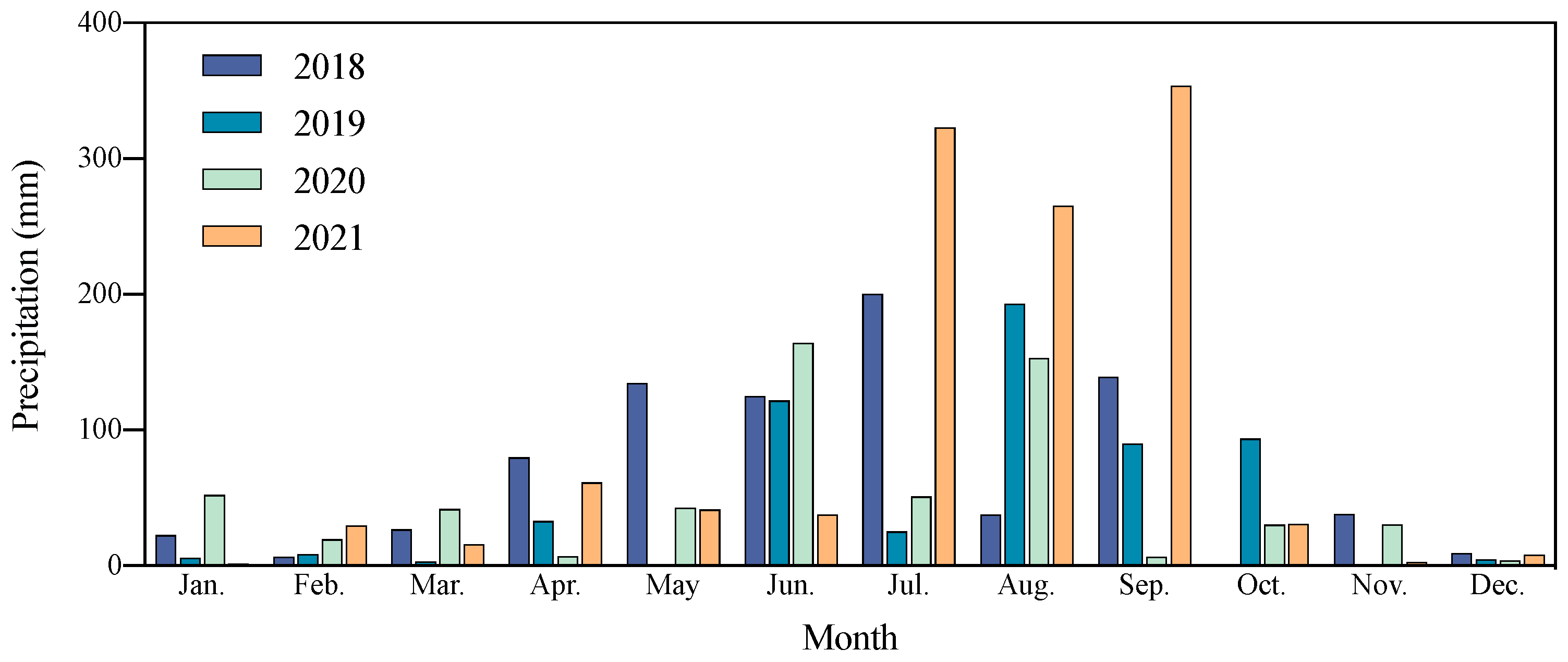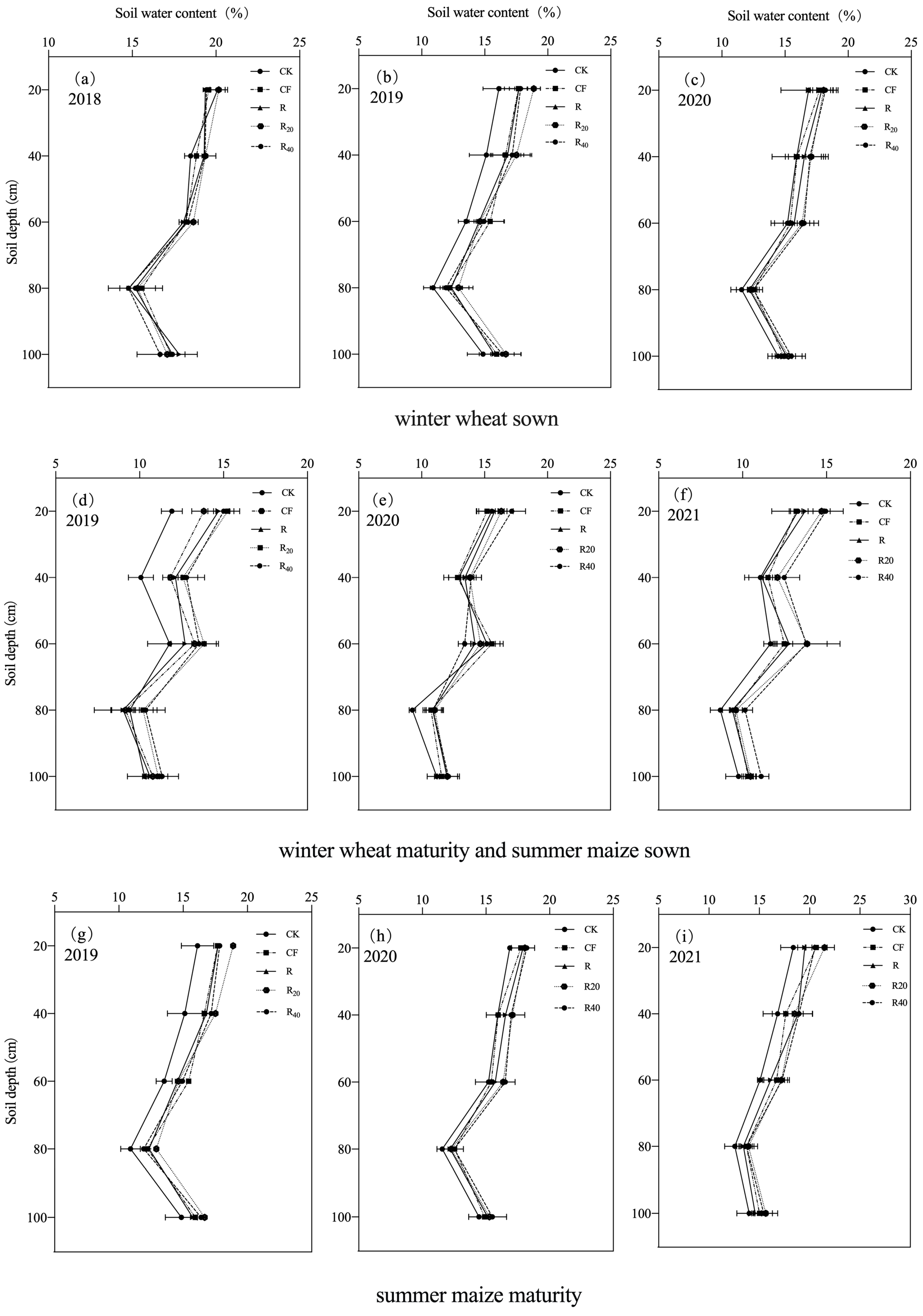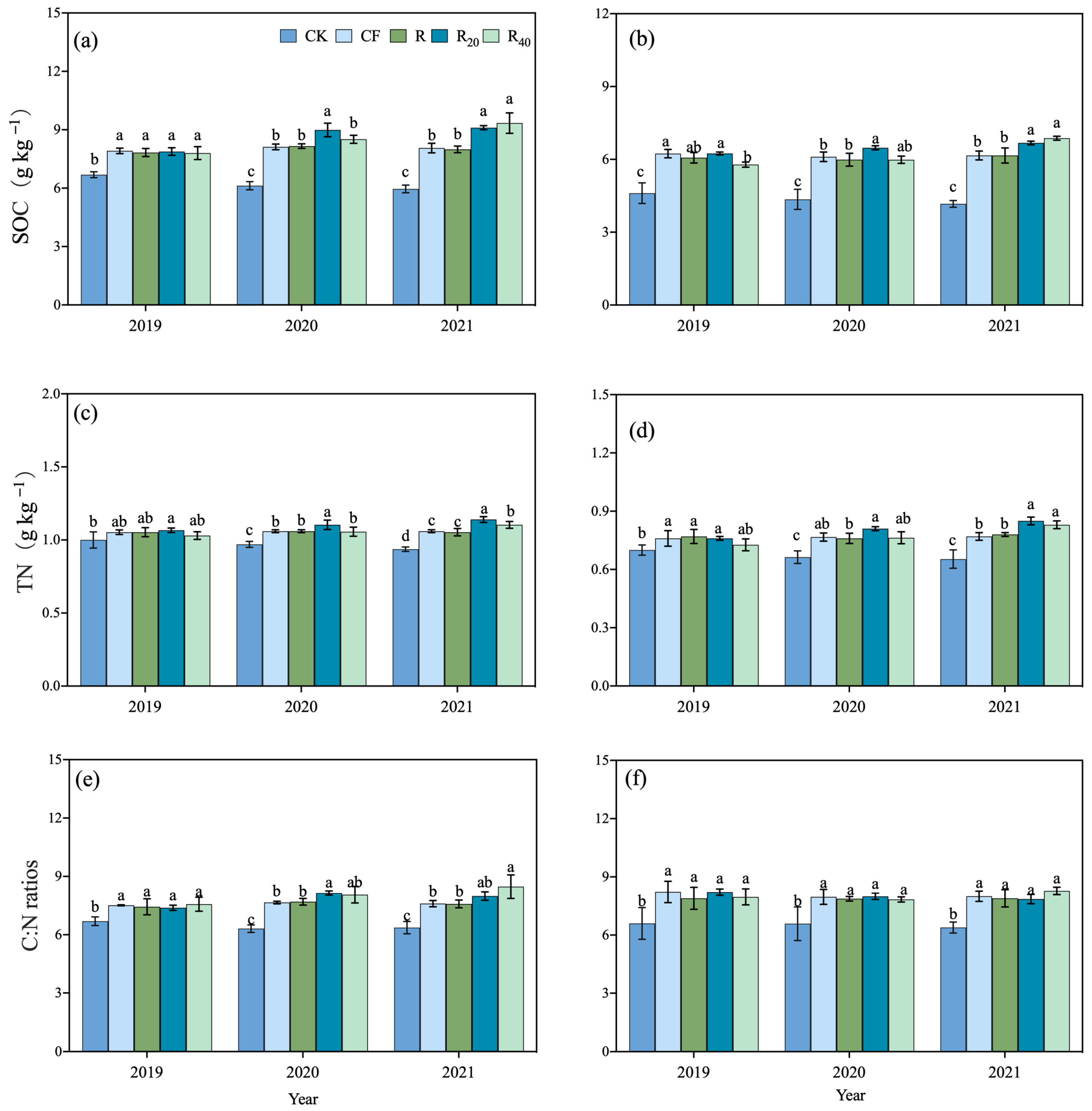Effects of Partial Substitution of Organic Fertilizer for Synthetic N Fertilizer on Yield and N Use Efficiencies in a Semiarid Winter Wheat–Summer Maize Rotation
Abstract
:1. Introduction
2. Materials and Methods
2.1. Experimental Site Description
2.2. Experimental Design and Management
2.3. Data Collection
2.3.1. Dry Matter Accumulation and Nitrogen Uptake
2.3.2. Yield
2.3.3. N Efficiency
2.3.4. Soil Water Status and Water Use Efficiency
2.3.5. Soil Sampling and Analysis
2.4. Statistical Analyses
3. Results
3.1. Dry Matter Accumulation and Nitrogen Uptake
3.2. Crop Yield
3.3. Nitrogen Use Efficiency
3.4. Soil Moisture and Water Use Efficiency
3.5. Soil Organic Carbon and Total Nitrogen Concentrations and Carbon: Nitrogen Ratio
4. Discussion
5. Conclusions
Author Contributions
Funding
Data Availability Statement
Conflicts of Interest
References
- Li, H.Y.; Zhang, Y.H.; Sun, Y.G.; Liu, P.Z.; Zhang, Q.; Wang, X.L.; Wang, C. Long-term effects of optimized fertilization, tillage and crop rotation on soil fertility, crop yield and economic profit on the Loess Plateau. Eur. J. Agron. 2023, 143, 126731. [Google Scholar] [CrossRef]
- Yang, J.; Gao, W.; Ren, S.R. Long-term effects of combined application of chemical nitrogen with organic materials on crop yields, soil organic carbon and total nitrogen in fluvo-aquic soil. Soil Tillage Res. 2015, 151, 67–74. [Google Scholar] [CrossRef]
- Liu, Z.; Gao, J.; Gao, F.; Dong, S.T.; Liu, P.; Zhao, B.; Zhang, J.W. Integrated agronomic practices management improve yield and nitrogen balance in double cropping of winter wheat-summer maize. Field Crop. Res. 2018, 221, 196–206. [Google Scholar] [CrossRef]
- Guo, J.H.; Liu, X.J.; Zhang, Y.; Shen, J.L.; Han, W.X.; Zhang, W.F.; Christie, P.; Goulding, K.W.T.; Vitousek, P.M.; Zhang, F.S. Significant acidification in major Chinese croplands. Science 2010, 327, 1008–1010. [Google Scholar] [CrossRef] [PubMed]
- Liu, X.; Xu, S.S.; Zhang, J.W.; Ding, Y.F.; Li, J.H.; Wang, S.H.; Liu, Z.H.; Tang, S.; Dong, C.Q.; Chen, L. Effect of continuous reduction of nitrogen application to a rice-wheat rotation system in the middle-lower Yangtze River region (2013–2015). Field Crop. Res. 2016, 196, 348–356. [Google Scholar] [CrossRef]
- Zhao, K.N.; Wang, H.T.; Wu, J.Z.; Liu, A.K.; Huang, X.L.; Li, G.Q.; Wu, S.W.; Zhang, J.; Zhang, Z.W.; Hou, Y.Q.; et al. One-off irrigation improves water and nitrogen use efficiency and productivity of wheat as mediated by nitrogen rate and tillage in drought-prone areas. Field Crop. Res. 2023, 295, 108898. [Google Scholar] [CrossRef]
- He, H.; Peng, M.W.; Lu, W.D.; Li, J.H. Commercial organic fertilizer substitution increases wheat yield by improving soil quality. Sci. Total Environ. 2022, 851, 158132. [Google Scholar] [CrossRef] [PubMed]
- Giola, P.; Basso, B.; Pruneddu, G.; Giunta, F.; Jones, J.W. Impact of manure and slurry applications on soil nitrate in a maize–triticale rotation: Field study and long term simulation analysis. Eur. J. Agron. 2012, 38, 43–53. [Google Scholar] [CrossRef]
- Shi, Z.J.; Liu, D.H.; Liu, M.; Hafeez, M.B.; Wen, P.F.; Wang, X.L.; Wang, R.; Zhang, X.D.; Li, J. Optimized fertilizer recommendation method for nitrate residue control in a wheat–maize double cropping system in dryland farming. Field Crop. Res. 2021, 271, 108258. [Google Scholar] [CrossRef]
- Yang, X.L.; Lu, Y.L.; Ding, Y.; Yin, X.F.; Raza, S.; Tong, Y.A. Optimising nitrogen fertilisation: A key to improving nitrogen-use efficiency and minimising nitrate leaching losses in an intensive wheat/maize rotation (2008–2014). Field Crop. Res. 2017, 206, 1–10. [Google Scholar] [CrossRef]
- Fallah, S.; Rostaei, M.; Lorigooini, Z.; Surki, A.A. Chemical compositions of essential oil and antioxidant activity of dragonhead (Dracocephalum moldavica) in sole crop and dragonhead-soybean (Glycine max) intercropping system under organic manure and chemical fertilizers. Ind. Crop. Prod. 2018, 115, 158–165. [Google Scholar] [CrossRef]
- Guo, Y.J.; Qiu, T.L.; Gao, M.; Ru, S.H.; Gao, H.Z.; Wang, X.M. Does increasing the organic fertilizer application rate always boost the antibiotic resistance level in agricultural soils? Environ. Pollut. 2023, 322, 121251. [Google Scholar] [CrossRef]
- Jiang, Y.P.; Li, K.R.; Chen, S.F.; Fu, X.L.; Feng, S.Y.; Zhuang, Z.S. A sustainable agricultural supply chain considering substituting organic manure for chemical fertilizer. Sustain. Prod. Consum. 2022, 29, 432–446. [Google Scholar] [CrossRef]
- Cai, A.D.; Xu, M.G.; Wang, B.R.; Zhang, W.J.; Liang, G.P.; Hou, E.Q.; Li, Y.Q. Manure acts as a better fertilizer for increasing crop yields than synthetic fertilizer does by improving soil fertility. Soil Tillage Res. 2019, 189, 168–175. [Google Scholar] [CrossRef]
- Jia, R.; Zou, J.; Chu, J.C.; Shahbaz, M.; Yang, Y.D.; Jones, D.L.; Zang, H.D.; Razavi, B.S.; Zeng, Z.H. Insights into the associations between soil quality and ecosystem multifunctionality driven by fertilization management: A case study from the North China Plain. J. Clean. Prod. 2022, 362, 132265. [Google Scholar] [CrossRef]
- Wang, L.L.; Li, Q.; Coulter, J.A.; Xie, J.H.; Luo, Z.Z.; Zhang, R.Z.; Deng, X.P.; Li, L.L. Winter wheat yield and water use efficiency response to organic fertilization in northern China: A meta-analysis. Agric. Water Manag. 2020, 229, 105934. [Google Scholar] [CrossRef]
- Li, Z.D.; Jiao, Y.Q.; Yin, J.; Li, D.; Wang, B.B.; Zhang, K.L.; Zheng, X.X.; Hong, Y.; Zhang, H.X.; Xie, C.; et al. Productivity and quality of banana in response to chemical fertilizer reduction with bio-organic fertilizer: Insight into soil properties and microbial ecology. Agric. Ecosyst. Environ. 2021, 322, 107659. [Google Scholar] [CrossRef]
- Wei, W.L.; Yan, Y.; Cao, J.; Christie, P.; Fan, M.S. Effects of combined application of organic amendments and fertilizers on crop yield and soil organic matter: An integrated analysis of long-term experiments. Agric. Ecosyst. Environ. 2016, 225, 86–92. [Google Scholar] [CrossRef]
- Liu, B.; Wang, X.Z.; Ma, L.; Chadwick, D.; Chen, X.P. Combined applications of organic and synthetic nitrogen fertilizers for improving crop yield and reducing reactive nitrogen losses from China’s vegetable systems: A meta-analysis. Environ. Pollut. 2021, 269, 116143. [Google Scholar] [CrossRef]
- Zhai, L.C.; Wang, Z.B.; Zhai, Y.C.; Zhang, L.H.; Zheng, M.J.; Yao, H.P.; Lv, L.H.; Sheng, H.P.; Zhang, J.T.; Yao, Y.R.; et al. Partial substitution of chemical fertilizer by organic fertilizer benefits grain yield, water use efficiency, and economic return of summer maize. Soil Tillage Res. 2022, 217, 105287. [Google Scholar] [CrossRef]
- Yang, Z.C.; Zhao, N.; Huang, F.; Lv, Y.Z. Long-term effects of different organic and inorganic fertilizer treatments on soil organic carbon sequestration and crop yields on the North China Plain. Soil Tillage Res. 2015, 146, 47–52. [Google Scholar] [CrossRef]
- Wang, X.Q.; Yang, Y.D.; Zhao, J.; Nie, J.W.; Zang, H.D.; Zeng, Z.H.; Olesen, J.E. Yield benefits from replacing chemical fertilizers with manure under water deficient conditions of the winter wheat–summer maize system in the North China Plain. Eur. J. Agron. 2020, 119, 126118. [Google Scholar] [CrossRef]
- Xin, X.L.; Qin, S.W.; Zhang, J.B.; Zhu, A.M.; Yang, Y.L.; Zhang, X.F. Yield, phosphorus use efficiency and balance response to substituting long-term chemical fertilizer use with organic manure in a wheat-maize system. Field Crop. Res. 2017, 208, 27–33. [Google Scholar] [CrossRef]
- He, H.; Peng, M.W.; Ru, S.B.; Hou, Z.N.; Li, J.H. A suitable organic fertilizer substitution ratio could improve maize yield and soil fertility with low pollution risk. Front. Plant Sci. 2022, 13, 988663. [Google Scholar] [CrossRef] [PubMed]
- Duan, Y.H.; Xu, M.G.; Gao, S.D.; Yang, X.Y.; Huang, S.M.; Liu, H.B.; Wang, B.R. Nitrogen use efficiency in a wheat–corn cropping system from 15 years of manure and fertilizer applications. Field Crop. Res. 2014, 157, 47–56. [Google Scholar] [CrossRef]
- Huang, L.N.; Cheng, S.M.; LIU, H.L.; Zhao, Z.X.; Wei, S.X.; Sun, S.H. Effects of nitrogen reduction combined with organic fertilizer on growth and nitrogen fate in banana at seedling stage. Environ. Res. 2022, 214, 113826. [Google Scholar] [CrossRef]
- Wang, X.B.; Cai, D.Y.; Jin, K.; Wu, H.J.; Bai, Z.G.; Zhang, C.J.; Yao, Y.Q.; Lv, J.J.; Wang, Y.H.; Yang, B.; et al. Water Availability for Winter Wheat Affected by Summer Fallow Tillage Practices in Sloping Dryland. Sci. Agric. Sin. 2003, 36, 1044–1049. (In Chinese) [Google Scholar]
- Nelson, D.W.; Sommers, L.E. Total carbon, organic carbon, and organic matter. In Methods of Soil Analysis: Part 2 Chemical and Microbiological Properties; Page, A.L., Ed.; American Society of Agronomy: Madison, WI, USA; Soil Science Society of America: Madison, WI, USA, 1983; pp. 539–579. [Google Scholar]
- Zhou, Z.K.; Zhang, S.Y.S.; Jiang, N.; Xiu, W.M.; Zhao, J.N.; Yang, D.L. Effects of organic fertilizer incorporation practices on crops yield, soil quality, and soil fauna feeding activity in the wheat-maize rotation system. Front. Environ. Sci. 2022, 10, 2292. [Google Scholar] [CrossRef]
- Gallet, C.; Boissier, J.M.; Berlandis, M. Short-term effects of manure application on soil leachates in a mountain catchment. Agronomie 2003, 23, 335–344. [Google Scholar] [CrossRef]
- Sądej, W.; Żołnowski, A.C.; Marczuk, O. Content of phenolic compounds in soils originating from two long-term fertilization experiments. Arch. Environ. Prot. 2016, 42, 104–113. [Google Scholar] [CrossRef]
- Zhai, L.C.; Zhang, L.H.; Cui, Y.Z.; Zhai, L.F.; Zheng, M.J.; Yan, Y.R.; Zhang, J.T.; Hou, W.B.; WU, L.Y.; Jia, X.L. Combined application of organic fertilizer and chemical fertilizer alleviates the kernel position effect in summer maize by promoting post-silking nitrogen uptake and dry matter accumulation. J. Integr. Agric. 2023, in press. [Google Scholar]
- Yu, L.Y.; Zhao, X.N.; Gao, X.D.; Jia, R.H.; Yan, M.H.; Yang, X.L.; Wu, Y.; Siddique, K.H. Effect of natural factors and management practices on agricultural water use efficiency under drought: A meta-analysis of global drylands. J. Hydrol. 2021, 594, 125977. [Google Scholar] [CrossRef]
- Gan, Y.T.; Siddique, K.H.; Turner, N.C.; Li, X.G.; Niu, J.Y.; Yang, C.; Liu, L.P.; Chai, Q. Ridge-furrow mulching systems—An innovative technique for boosting crop productivity in semiarid rain-fed environments. Adv. Agron. 2013, 118, 429–476. [Google Scholar]
- Fan, T.L.; Stewart, B.A.; Wang, Y.; Luo, J.J.; Zhou, G.Y. Long-term fertilization effects on grain yield, water-use efficiency and soil fertility in the dryland of Loess Plateau in China. Agric. Ecosyst. Environ. 2005, 106, 313–329. [Google Scholar] [CrossRef]
- Liu, C.A.; LI, F.R.; Zhou, L.M.; Zhang, R.H.; Jia, Y.; Lin, S.L.; Wang, L.J.; Siddique, K.H.; Li, F.M. Effect of organic manure and fertilizer on soil water and crop yields in newly-built terraces with loess soils in a semi-arid environment. Agric. Water Manag. 2013, 117, 123–132. [Google Scholar] [CrossRef]
- Wang, L.L.; WANG, S.W.; Chen, W.; Li, H.B.; Deng, X.P. Physiological mechanisms contributing to increased water-use efficiency in winter wheat under organic fertilization. PLoS ONE 2017, 12, e0180205. [Google Scholar] [CrossRef] [PubMed]
- Wang, J.; Liu, W.Z.; Dang, T.H. Responses of soil water balance and precipitation storage efficiency to increased fertilizer application in winter wheat. Plant Soil. 2011, 347, 41–51. [Google Scholar] [CrossRef]
- Chen, W.; Deng, X.P.; Kwark, S.S.; Eneji, A.E. The relationship between yield and fructan exo-hydrolases activity in two drought resistant wheat cultivars grown under different fertilizer and tillage treatments. J. Plant Nutr. 2015, 38, 13–27. [Google Scholar] [CrossRef]
- Zhang, X.B.; Sun, N.; Wu, L.H.; Xu, M.G.; Bingham, L.J.; Li, Z.F. Effects of enhancing soil organic carbon sequestration in the topsoil by fertilization on crop productivity and stability: Evidence from long-term experiments with wheat-maize cropping systems in China. Sci. Total Environ. 2016, 562, 247–259. [Google Scholar] [CrossRef]
- Huang, S.H.; He, P.; Jia, L.L.; Den, W.C.; Ullah, S.; Zhao, R.R.; Zhang, J.J.; Xu, X.P.; Liu, M.C.; Zhou, W. Improving nitrogen use efficiency and reducing environmental cost with long-term nutrient expert management in a summer maize-winter wheat rotation system. Soil Till. Res. 2021, 213, 105117. [Google Scholar] [CrossRef]
- Liang, Q.; Chen, H.Q.; Gong, Y.S.; Fang, M.S.; Yang, H.F.; Lai, R.; Kuzyakov, Y. Effects of 15 years of manure and inorganic fertilizers on soil organic carbon fractions in a wheat-maize system in the North China Plain. Nutr. Cycl. Agroecosys. 2012, 92, 21–33. [Google Scholar] [CrossRef]
- Liu, M.; Linna, C.; Ma, S.M.; Ma, Q.; Guo, J.G.; Wang, F.F.; Wang, L.C. Effects of biochar with inorganic and organic fertilizers on agronomic traits and nutrient absorption of soybean and fertility and microbes in purple soil. Front. Plant Sci. 2022, 13, 871021. [Google Scholar] [CrossRef] [PubMed]
- Liu, J.A.; Shu, A.P.; Song, W.F.; Shi, W.C.; Li, M.C.; Zhang, W.X.; Li, Z.Z.; Liu, G.R.; Yuan, F.S.; Zhang, S.X.; et al. Long-term organic fertilizer substitution increases rice yield by improving soil properties and regulating soil bacteria. Geoderma 2021, 404, 115287. [Google Scholar] [CrossRef]
- Ning, C.C.; Gao, P.D.; Wang, B.Q.; Lin, W.P.; Jiang, N.H.; Cai, K.Z. Impacts of chemical fertilizer reduction and organic amendments supplementation on soil nutrient, enzyme activity and heavy metal content. J. Integr. Agric. 2017, 16, 1819–1831. [Google Scholar] [CrossRef]
- Zhang, Y.L.; Li, C.H.; Wang, Y.W.; Hu, Y.M.; Christie, P.; Zhang, J.L.; Li, X.L. Maize yield and soil fertility with combined use of compost and inorganic fertilizers on a calcareous soil on the North China Plain. Soil Tillage Res. 2016, 155, 85–94. [Google Scholar] [CrossRef]
- Liu, H.W.; Du, X.F.; LI, Y.B.; Han, X.; Li, B.; Zhang, X.K.; Li, Q.; Liang, W.J. Organic substitutions improve soil quality and maize yield through increasing soil microbial diversity. J. Clean. Prod. 2022, 347, 131323. [Google Scholar] [CrossRef]
- Zhang, D.J.; Guo, Y.X.; Fan, Z.Y.; Hu, X.; Hao, X.R.; Fang, L.; Li, C.X. Trade-offs between grain yields and ecological efficiencies in a wheat–maize cropping system using optimized tillage and fertilization management on the North China Plain. Environ. Sci. Pollut. Res. 2023, 30, 24479–24493. [Google Scholar] [CrossRef]






| Year | Treatment | Winter Wheat | Summer Maize | ||||
|---|---|---|---|---|---|---|---|
| NAE | NPFP | NUE | NAE | NPFP | NUE | ||
| 2018–2019 | CK | — | — | — | — | — | — |
| CF | 6.62 a | 32.15 c | 31.22 b | 8.88 ab | 46.61 c | 25.95 c | |
| R | 8.67 a | 40.59 a | 41.25 a | 11.24 a | 58.41 a | 30.38 b | |
| R20 | 7.85 a | 39.77 a | 41.38 a | 10.68 a | 57.85 a | 37.08 a | |
| R40 | 2.79 b | 34.71 b | 22.09 c | 5.20 b | 52.36 b | 18.36 d | |
| 2019–2020 | CK | — | — | — | — | — | — |
| CF | 9.19 b | 31.74 c | 27.59 b | 11.72 c | 45.67 d | 18.67 b | |
| R | 11.69 b | 39.86 b | 35.60 b | 15.31 b | 57.74 b | 21.42 b | |
| R20 | 17.96 a | 46.14 a | 59.77 a | 20.80 a | 63.23 a | 29.99 a | |
| R40 | 9.07 b | 37.25 b | 26.88 b | 11.38 c | 53.81 c | 18.67 b | |
| 2020–2021 | CK | — | — | — | — | — | — |
| CF | 8.90 c | 31.25 c | 32.55 c | 11.16 c | 44.89 c | 28.74 b | |
| R | 10.48 b | 38.42 b | 37.15 c | 13.47 bc | 55.64 b | 32.49 b | |
| R20 | 17.47 a | 45.42 a | 54.04 a | 18.40 a | 60.56 a | 42.11 a | |
| R40 | 13.55 b | 41.50 b | 43.40 b | 16.14 ab | 58.31 ab | 39.14 a | |
| Average | CK | — | — | — | — | — | — |
| CF | 8.24 c | 31.71 d | 30.45 b | 10.59 c | 45.72 d | 24.45 c | |
| R | 10.28 b | 39.62 b | 38.00 b | 13.34 b | 57.26 b | 28.10 b | |
| R20 | 14.43 a | 43.78 a | 51.73 a | 16.63 a | 60.55 a | 36.39 a | |
| R40 | 8.47 c | 37.82 c | 30.79 b | 10.90 c | 54.83 c | 25.39 c | |
| F-values | |||||||
| Y | ** | * | ns | ** | ns | ** | |
| T | ** | ** | ** | ** | ** | ** | |
| Y × T | ** | ** | * | * | * | ** | |
Disclaimer/Publisher’s Note: The statements, opinions and data contained in all publications are solely those of the individual author(s) and contributor(s) and not of MDPI and/or the editor(s). MDPI and/or the editor(s) disclaim responsibility for any injury to people or property resulting from any ideas, methods, instructions or products referred to in the content. |
© 2023 by the authors. Licensee MDPI, Basel, Switzerland. This article is an open access article distributed under the terms and conditions of the Creative Commons Attribution (CC BY) license (https://creativecommons.org/licenses/by/4.0/).
Share and Cite
Lv, M.; Huang, M.; Zhao, K.; Gu, X.; Li, S.; Wang, J.; Yin, F.; Liu, L.; Jiao, N.; Fu, G. Effects of Partial Substitution of Organic Fertilizer for Synthetic N Fertilizer on Yield and N Use Efficiencies in a Semiarid Winter Wheat–Summer Maize Rotation. Agronomy 2023, 13, 2281. https://doi.org/10.3390/agronomy13092281
Lv M, Huang M, Zhao K, Gu X, Li S, Wang J, Yin F, Liu L, Jiao N, Fu G. Effects of Partial Substitution of Organic Fertilizer for Synthetic N Fertilizer on Yield and N Use Efficiencies in a Semiarid Winter Wheat–Summer Maize Rotation. Agronomy. 2023; 13(9):2281. https://doi.org/10.3390/agronomy13092281
Chicago/Turabian StyleLv, Meng, Ming Huang, Kainan Zhao, Xinxin Gu, Siqi Li, Jiangtao Wang, Fei Yin, Ling Liu, Nianyuan Jiao, and Guozhan Fu. 2023. "Effects of Partial Substitution of Organic Fertilizer for Synthetic N Fertilizer on Yield and N Use Efficiencies in a Semiarid Winter Wheat–Summer Maize Rotation" Agronomy 13, no. 9: 2281. https://doi.org/10.3390/agronomy13092281





